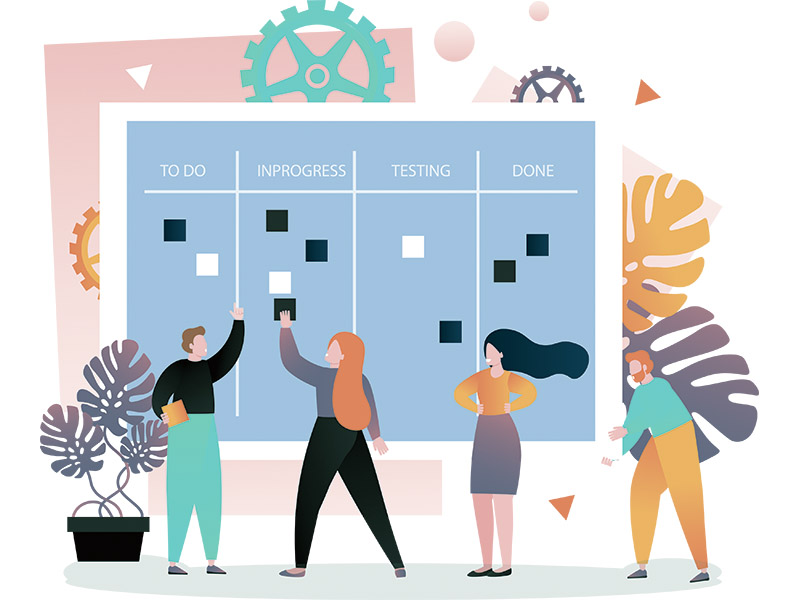
Product Management Career Paths
Product Management is an exciting and unique career path that covers the entire lifecycle from ideation growth and eventual retirement of the product. The role of Product Management itself can vary significantly depending on your position within the Product organization – from a mostly tactical role focused on defining features, to working with executives and the board to construct the longer-term strategy. The role that you play has a lot to do with your seniority and the size of the team. With this article, we’ll explore how Product teams are often configured, the most common levels and titles you’re likely to see, and the career steps, as you build a career in Product Management.
Product Team Stratification
When you’re in a startup, the needs of a Product org are relatively contained and you might have a single Product Manager or ‘Head of Product’ doing it all, from talking to customers and strategy, to writing the user stories and user acceptance testing. As the organization grows, there are more and more people sharing the responsibilities of Product Management.
The first step of stratification is to divide in to 2 layers – the “heads up” product leadership role that focuses on opportunity discovery, planning, and alignment, and the “heads down” tactical role of feature definition and working directly with the product development team. This structure could support as many as 4-5 Product Managers reporting to a Head of Product. If the team is fortunate enough to grow beyond that, a 3-tier model is a common configuration.
The Head of Product takes a more formal upper management title such as VP or Chief Product Officer (CPO) and becomes the primary executive representative with upper management. Their focus shifts upward to organizational alignment, seeking funding, building the team, and portfolio level planning and allocation with the executive product council. A second layer to the team is introduced for planning the actual product strategy and roadmap at the program level, that is often represented by one or more Directors of Product. The individual contributor Product Managers continue to assume the more tactical Product Owner responsibilities with the product development teams.
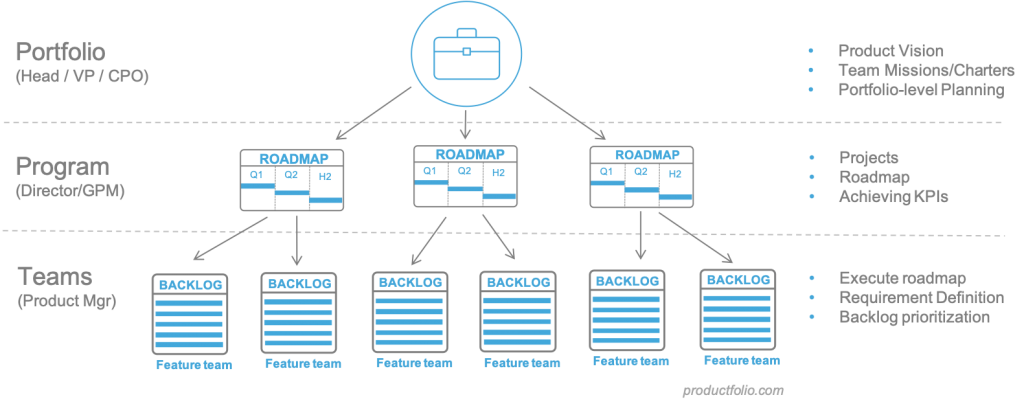
Typical Team Configuration
Every functional department is shaped as a pyramid, with a head of that group at the top. Product Directors report directly to the Head of Product, each with a specific mission or focus area to develop a strategy for, and the contributing Product Managers report into the Product Directors, supporting those strategic missions.
User Experience (UX) is typically a part of the Product organization, though the reporting hierarchy can vary – either a mini UX team can exist within Product and report directly into the Head of Product, or UX will be de-centralized, with a UX contributor reporting into each of the Product Directors with that need. The latter is generally the preferred pattern, in order to align resources to the missions of those teams.
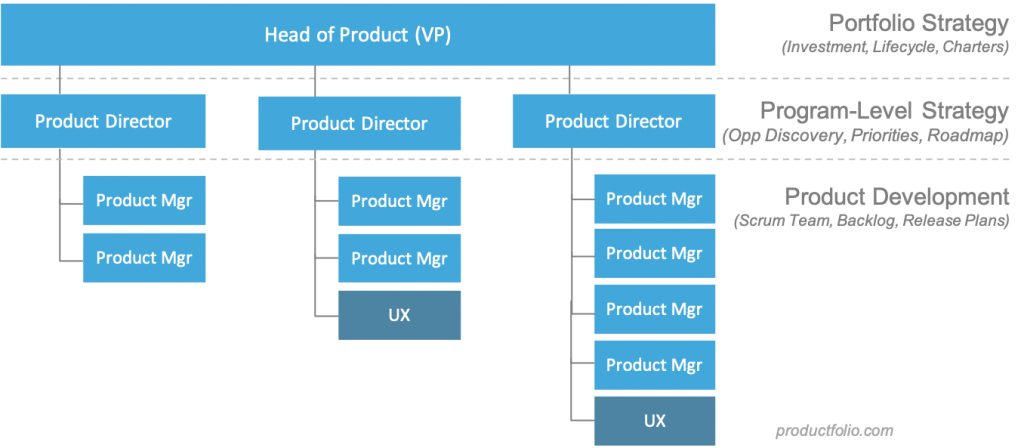
Role-by-Role Comparison
With organizational structures established, let’s discuss the most common titles within a Product organization and what each of these is responsible for. It is worth noting that very few organizations have all of these titles, and some of them overlap with one another. We’ll discuss these nuances as we go through each of them below:
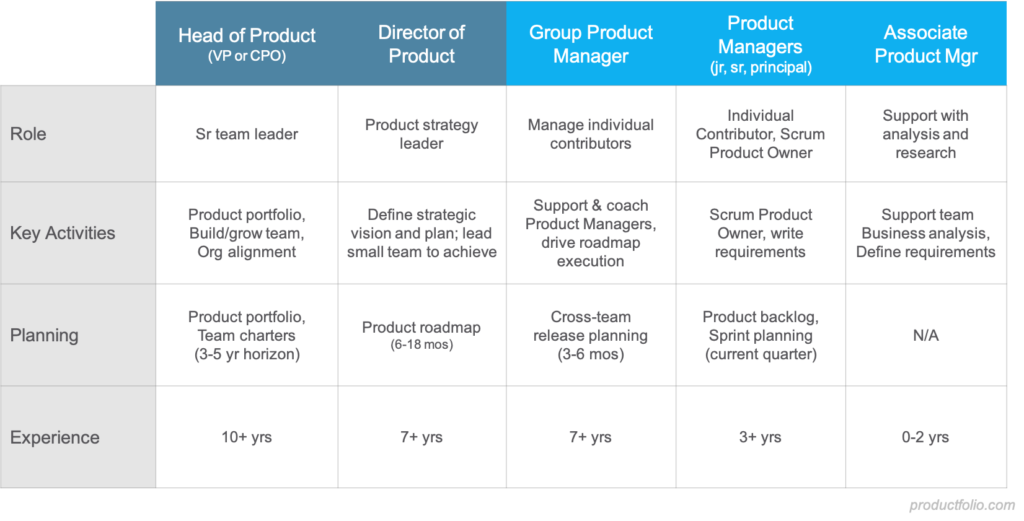
Head of Product (Chief Product Office or VP, Product)
The Head of Product is the top of the Product organizational pyramid. Responsibilities can very significantly depending on the size and scale of the organization. In a smaller starter up, this person wears many hats and is as tactical as they are strategic. When someone holds the title of “Head of Product” at a startup, it is typically equal to a Director of Product at a larger organization.
At a larger organization, the head of Product is typically either VP of Product or maybe even Chief Product Officer (CPO), where Product is elevated to the executive level. This role is the ‘chief diplomat’ and advocate of the Product Management team, advocating for the team, seeking support for Product priorities and attaining resources to pursue those priorities. They typically report to the President of the company and work with the President and other executives on the overall product portfolio strategy, determining high-level allocation of resources and initiatives that the Product team will pursue.
Director of Product Manager
Depending on the size of the organization and importance of Product Management within the company, a Director of Product might report into a Head of Product (VP or CPO), or Product is of lower importance within the organization, the Director could be the highest-level Product leader in the organization, typically reporting into a divisional business leader in those cases. Regardless of reporting lines, the Director of Product is a product leader role, that responsible for product strategy, roadmap planning, and leadership of a smaller Product team that aligns to the mission that Product Director is charged with.
A Product Director does not always manage other Product Managers however. In fact, it is common in recent years to see more Product Directors positioned as Principal Product Managers who have Director-level compensation, decision authority, and lead larger product initiatives, but not necessarily with their own team. That aspect of the Product Director’s role is considerable variable. What is constant however, is that they’re typically the role setting the strategy and plan for the product.
Group Product Manager (GPM)
The GPM is typically only seen on larger Product teams, where the individual contributor Product Managers are out-number Product Directors (typically greater than a 5:1 ratio) and so an additional layer is added to efficiently conduct the efforts of those teams. It is a transitional leadership role in that it is often partly hands-on and partly managerial. It is not uncommon to see the GPM writing stories for a team while also asking their team to contribute stories to the same initiative.
A Group Product Manager is responsible for supporting 2-4 Product Managers as a manager, and keeping that team focused on efficient execution of the roadmap, that is owned at the Director level. The GPM may have input on strategic planning, but is principally charged with executing it, not defining it.
Principal Product Manager (Lead Product Manager)
The Principal Product Manager (aka Lead Product Manager) is a rare role that reserved for the strongest and more experienced individual contributor Product Managers. It is the top of the food chain for Product Managers who do not wish to go into people management. They’re often tasked with the largest and most important initiatives because they are highly trusted in their abilities.
Compensation for Principal Product Managers can be as high as a Director though they do not have the same people management responsibilities or authority. Because their seniority is comparable, compensation is often comparable to the director-level as well.
Product Manager (Senior Product Manager)
The Product Manager is the core of the Product team. They are individual contributors who are focused on product development – writing requirements and acceptance criteria, performing user acceptance testing (UAT), and setting priorities for their teams on a sprint-by-sprint basis.
When practicing Agile/Scrum product development, the Product Manager will often play the Scrum Product Owner role for their product development team/squad. It is not uncommon for a Product Manager to embed with this team and sit co-located with them, to reduce barriers and improve communication.
A Sr Product Manager has many of the same responsibilities as the Product Manager, but more experience and thus greater title and compensation. A Sr Product Manager is expected to be able to carry more significant and more complex projects/initiatives than their more junior counterparts.
Associate Product Manager
An Associate Product Manager (APM) is typically someone directly out of school, who is joining the Product Team in a supportive role, but without any of the decision authority of a full-fledged Product Manager. The APM is similar to a Business Analyst role insofar as they perform analysis and make recommendations but they ultimately defer to someone else in the Product org to make decisions. Still, this can be a great way for someone to observe the process first-hand and learn the craft of Product Mgmt, while also creating value to the team in the process.
Product Career Ladder
If you’re planning a career in Product Management, consider all of those titles and where they fit into your career path. There are two tracks in Product – individual contributor (IC), and leadership. Most careers in Product start as an Individual Contributor role, where the PM will spend a few years in various roles of increasing responsibility before having to decide if they want to make the leap to leadership or not.
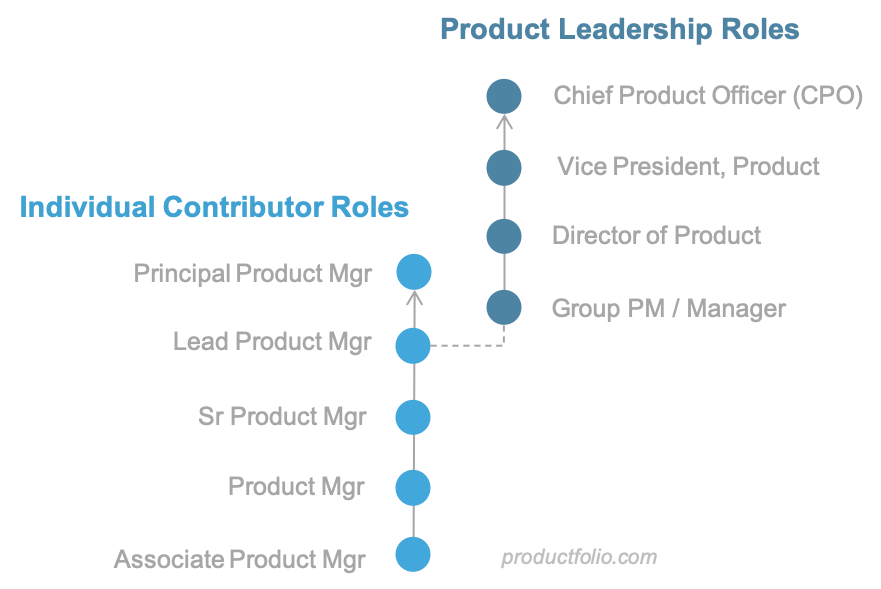
If the goal is to make the leap to leadership, that typically happens around the time of being Senior or Lead Product Manager, into a Group Product Manager role (also sometimes called Manager of Product Management). Not everyone wants to go into management and leadership however, in which case they may stay on the IC track, with the goal of becoming a Principal Product Manager.
Conclusion
Hopefully, this helps to clarify the structure of Product organizations, and the role and responsibilities that go with the most common titles. Product Management is an exciting and fulfilling career track and there are numerous opportunities to align your own interests and strengths while growing your career, whether your interest is building products, defining and planning program-level strategy, or leading teams at an executive level.
More Learning Guides
Role of Product Management
Product Management is different in every organization, but there are fundamentals that transcend the differences and define the role.
Product Strategy
You've got a roadmap full of features to deliver, but are they the right features? Are you solving the needs of your customer?
Product Planning
Prioritization and placement of opportunities on a roadmap provides a plan for achieving business goals and the product vision.


